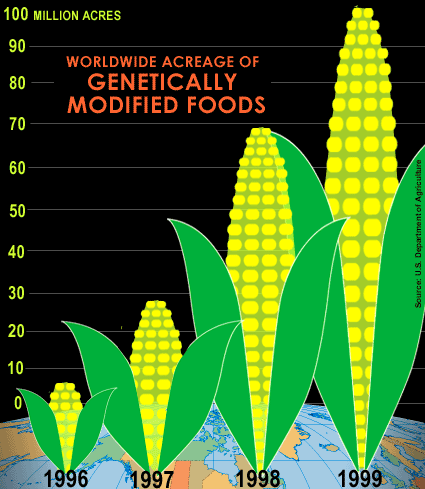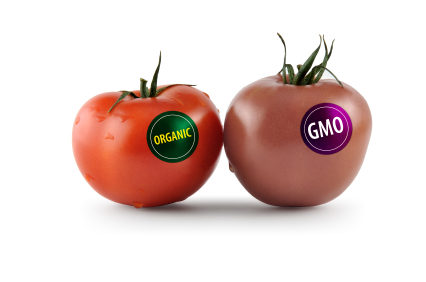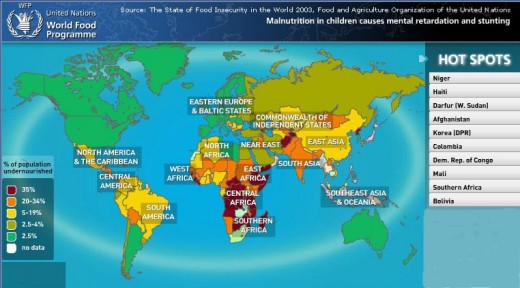Genetic Engineering: A Solution to World Hunger or Just Another Money Maker?



By Myranda Grecinger
The debate regarding genetic engineering has been going on for some time and is not likely to end anytime soon. The idea of genetic engineering as a solution to the food crisis has been a main focus in the debate but the issue is often clouded by the other aspects involved such as the ethics of genetic engineering. Since the first genetically engineered crops were approved for entry into the open market in 1987 their use has become widespread by farmers in the U.S. (Fernandez-Cornejo and Caswell, 2006) and in “2009, the Food and Drug Administration issued a final guidance for industry on the regulation of genetically engineered (GE) animals” (U.S. Food and Drug Administration, 2011) yet hunger still persists. While certainly the ability to clone animals and crops, enable them to produce at faster rates, grow at alarmingly unnatural rates, alleviate undesirable traits and even eliminate predispositions to certain illnesses and disease, can any of that truly ever play a part in resolving the issue of world hunger? While there are some promising aspects to possible improvement in the quality of the food supply for both livestock and humans through genetic engineering, there is little hope of using it as a solution to combat world hunger because the world hunger crisis has more to do with economics and politics than supply and production.
Genetic engineering can be a scary term to those that do not have all of the facts; little do they know that a great deal of the fresh produce and meats that they purchase at the local supermarket comes as a result of exactly that. According to a 2002 Earth Island Journal article “Biotechnology is one of tomorrow’s tools in our hands today. Slowing its acceptance is a luxury our hungry world cannot afford.” (Robbins, 2002) It is important to realize that “Genetic engineering is a tool that has greatly affected agriculture and will continue to bring dramatic advances in crop and animal production. Biotechnology has improved the quality of food, feed, and fiber, and it often lowers production costs and provides for a safer farm environment.” (Spears, 2011)
For several hundred years scientists and agriculturalists have been choosing particular plants and animals for their most useful and desirable traits. Because of the ingenuity of today’s biotechnologists farmers are able to yield crops in larger than natural size, in greater amounts and in a shorter period of time. Ranchers would not be able to produce the large amounts of high quality beef that have become a mainstay in the diets of many westerners without the amazing assistance they receive by administering growth hormones and practicing proper animal husbandry, which is its self a form of Genetic engineering. One benefit that has come from genetic engineering is the ability to eradicate the need for the use of certain pesticides on crops intended for consumption, this is accomplished through the introduction of the Bt gene which is found in a common soil bacteria called Bacillus thuringiensis. (Spears, 2011) There are really almost endless possibilities when it comes to genetic engineering, so it seems only natural that it should be the primary weapon to battle world hunger.
The methods in which to best utilize G.E. in the fight against world hunger are still under debate, there are so many options that honestly would do well in conjunction with one another. The issue of pests effecting crop growth and production which could most certainly be greatly assisted though the development of genetically engineered variants. Engineering certain crops to be able to be grown in environments other than what is naturally appropriate would prove highly useful especially with high yield crops in third world countries. Already a great deal of altered food and goods are available in western markets, “In the United States, for example, 68 percent of the soybeans, 70 percent of the cotton crop, 26 percent of corn and 55 percent of canola are genetically engineered. G.M.O.’s represent an estimated 60 percent of all American processed foods.” (Coleman, 2005) So realistically, it would seem as though the biggest issue is how to get these new crop and livestock strains to the parts of the world where they are needed most.
Unfortunately, contrary to popular belief the resolution to world hunger may not be as simple as altering a few species of plants and animals. According to a paper published in 1998 by Danielle knight “World hunger is extensive in spite of sufficient global food resources. Therefore increased food production is no solution. The problem is that many people are too poor to buy readily available food.” If that is true then the problem is not related to amounts of food or types of food available, it is an economic and political issue. No amount of genetic engineering is going to force market prices to a reasonable rate or force governments to make food available to their people.
“According to the American Association for the Advancement of Science, 78 percent of all malnourished children under five years old live in countries with food surpluses (Knight, 1998).” It is difficult for one to comprehend this issue entirely without having experienced it for their selves, but if people do not have access to proper foods or to the money to purchase them then they will not eat proper meals. It seems like a complex issue, but it is honestly very simple, the solution, unfortunately, is not. “Opponents of genetically modified organisms reply that the “real problems” causing hunger, especially in the developing world, are poverty, lack of education and training, unequal land distribution and lack of access to markets. The moral point they advance is that distribution, not production, is the key to solving hunger.” (Coleman, 2005) So, in order to find a solution to the world hunger crisis, all humans need to be working together to find an effective way to get the food to those who need it. The best scenario would probably be to find a way to make growing and raising food available to each family so that they become self-reliant for their food sources rather than dependent on outside sources.
One thing that must be addressed when discussing genetic engineering especially in consumables is the risks. All too often science seems to get ahead of its self when it begins to accomplish something and humans revile in the benefits without assessing the full extent of all of the negative impacts. Genetic engineering can get out of control and sometimes leads to some awful, albeit unintended results. The animal cruelty that is seen in factory farms comes as a result of genetic engineering, the idea of raising perfect animals in a confined area and getting a high yield product at a relatively low cost seems great at first, till one assesses the full situation and realizes that along with those great sounding things come unnatural feeding methods, chemical alterations, tons of painful treatments and injections, births that result in deformations due to defective line breeding in attempt to retain desirable genes, just to name a few. It is no longer the pretty picture it started out being.
Sometimes the negative impacts are simply unforeseen changes in the thing being altered or unforeseen effects they have on the ones consuming them. Hormone levels have been detected at unnatural rate in fish due to water contamination by human products containing hormones such as shampoos and detergents. Science in biotechnology has moved along so quickly that the rest of the world is struggling to keep up, the potential health issues resulting from genetically engineered consumables are still being studied and the data is not in yet they fill the shelves of every supermarket. Thankfully the U.S. government as well as other governments and organizations are beginning to address this issue, “severe concerns about genetically modified organisms used in the food and beverage industry are a major hurdle for any commercialization.” (Saerens, Duong and Nevoigt, 2010) Even with more study and tighter policies the jury is still out on the sustainability, usefulness and safety of G.E.
Public opinion seems to point to G.E. being the wrong solution as to how hunger problem could be resolved. “A variety of groups and people are questioning the motives behind biotechnology as the political causes of hunger appear to be ignored.” (Shah, 2002) Biotechnology is not addressing the true factors in the world hunger crisis so it simply does not make sense to keep lauding it as a savior so people in general have a problem with G.E. research being pushed as such. “Both the breeding of transgenic animals in order to increase their agricultural usefulness and genetically engineered foodstuffs are rejected (67% and 59%, respectively) even by a majority of those approving of genetic engineering” (Hampel, Pfenning & Peters, 2000) People do not want to consume altered food, they want natural food and it appears do not feel that modified crops or livestock are safe to consume and certainly do not want to advocate its use in areas that are poverty stricken.
New policies could be created that support a better distribution system. Addressing the real issues behind world hunger would be the way to begin changing things. Better efforts must be made at distribution and accessibility as well as encouragement towards self-sustainability. Modifying food sources is not going to put food in the bellies of hungry children. People need a way to obtain the food even if it means producing it themselves. The reality is that G.E. has become more of a money maker through the patenting of customized seed varieties than a way to feed the hungry. Producers want to get paid for their products and unfortunately getting food to impoverished areas is not going to get them paid, but getting the food to the area does not even guarantee that those who need it will receive it anyway. The real issues must be tended to on a combined international effort.
There are so many avenues left to travel with G.E., so many benefits to be exploited that should continue to be researched, but if world hunger is to be addressed, it must be on a geographical, political and economic level. Food production is not the issue, nor would genetically engineered crops or livestock address it if it was, the issue is distribution, accessibility and affordability. Policies must be put into place to address these issues as food should be a simple human right, not a privilege. While there are certainly some benefits to explore when it comes to genetic engineering and its use in the production of food, it is painfully obvious that ending world hunger is not one of them.
References
Coleman, Gerald, (2005) Is Genetic Engineering the Answer to Hunger?
Fernandez-Cornejo, Jorge and Caswell, Margriet, (2006) The First Decade of Genetically Engineered Crops in the United States USDA.gov
Hampel and Pfenning and Peters, (2000) Attitudes towards genetic engineering, New Genetics and Society, Vol. 19, No. 3, http://web.ebscohost.com/ehost/pdfviewer/pdfviewer?vid=7&hid=12&sid=7ad9edab-abfe-437e-9eea-bab16da6b76c%40sessionmgr15
Knight, Danielle, (1998) It is a myth that world hunger is due to scarcity of food: Increased food production is not the solution http://www.psrast.org/nowohu.htm
Robbins, John, (2002) Are Genetically Altered Foods The Answer to World Hunger?, Earth Island Journal, Winter Edition, http://www.earthisland.org/journal/index.php/eij/article/are_genetically_altered_foods_the_answer_to_world_hunger/
Saerens, S., Duong, C. C., & Nevoigt, E. (2010). Genetic improvement of brewer’s yeast: current state, perspectives and limits. Applied Microbiology & Biotechnology, 86(5), 1195-1212. doi:10.1007/s00253-010-2486-6 http://web.ebscohost.com/ehost/pdfviewer/pdfviewer?sid=7ad9edab-abfe-437e-9eea-bab16da6b76c%40sessionmgr15&vid=10&hid=12
Shah, Anup, (2002) "GE Technologies will solve world hunger" http://www.globalissues.org/article/190/ge-technologies-will-solve-world-hunger
Spears, J.F. (2011) BiotechKnowlogy, Genetic Engineering of Food, Feed, and Fiber: Understanding Genetic Engineering
U.S. Food and Drug Administration, (2011) Genetically Engineered Animals http://www.fda.gov/AnimalVeterinary/DevelopmentApprovalProcess/GeneticEngineering/GeneticallyEngineeredAnimals/default.htm
© 2012 Myranda Grecinger








